11447 AN INTERESTING OAK RECTANGULAR CENTER TABLE WITH PARQUETRY TOP, CONSTRUCTED OF TIMBERS FROM THE H.M.S. ROYAL GEORGE, H.M.S. BOYNE, H.M.S TEMERAIRE, AND STEAM SHIPS BELONGING TO THE STEAM NAVIGATION COMPANY English. Mid-Nineteenth Century. Measurements: Width: 43” (109.2 cm); Height: 30 1/4” (76.8 cm); Depth: 22 3/4” (57.7 cm).
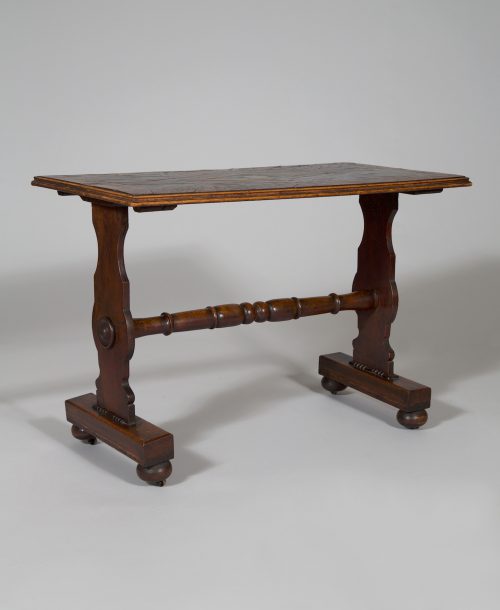
Research
Of natural and blackened oak. The rectangular top with inlaid double lozenges centered by an octagonal engraved brass plaque. The outer border with sawtooth inlaid design framed within chevron laid veneer. Enclosed by a shaped molding. The shaped standard ends rests upon plain rectangular blocks which are raised on bun feet enclosing original casters (one repaired). The ends united by a turned bulbous stretcher. Evidence of a screw fixing for brass plate.
Marks:
Engraved brass plaque reads:
The dark part of this table is made from/ Oak of/ H.M.S. Royal George/ Sunk at Spithead 29 July 1782/ The light is part of/ H.M.S Boyne/ Burnt at Spithead 1 May 1795/ The stem is part of H.M.S. Temeraire celebrated at/ Trafalgar/ The blocks & feet are made from oak of the/ City of Londonderry & The William Fawcet/ Steam ships belonging to the/ City of Dublin/ Steam Navigation Company
This interesting center table employs for its construction specimens of oak taken from various 18th and 19th century British sea vessels. An octagonal brass plaque at the center of the top reads:
The dark part of this table is made from/ Oak of/ H.M.S. Royal George/ Sunk at Spithead 29 Aug 1782/ The light is part of/ H.M.S Boyne/ Burnt at Spithead 1 May 1795/ The stem is part of H.M.S. Temeraire celebrated at/ Trafalgar/ The blocks & feet are made from oak of the/ City of Londonderry & The William Fawcet/ Steam ships belonging to the/ City of Dublin/ Steam Navigation Company
Immense quantities of timber were required for the building of a ship, and not all woods were suitable. Oak dominated as the preferred shipbuilding material for its weight and durability, resistance to decay, and strength in tension; it was especially ideal for ‘compass timber,’ where the wood is cut on a curve rather than straight, as the branches of an oak grow more or less horizontally from the trunk.1 “There was no finer material in Britain for the construction of ships’ hulls than English oak, and there was no finer oak in the entire country…than that found in the south-east.”2
The first ship mentioned, the H.M.S. Royal George was the largest warship in the world at the time of its launching in 1756. She took part in the Seven Years War and served as the flagship for two of the Royal Navy’s most notable admirals, Anson and Hawke. She also provided service during the American War of Independence and Siege of Gibralter circa 1780. Afterward, the ship returned to Britain for refitting. The tragic sinking of the ship took place on the 19th of August 1782 while she was anchored at Spithead to take on supplies and receive repairs. The ship was heeled over at an angle to accommodate maintenance work on the wash pump; the port side guns were run out and the starboard guns were drawn in to initiate the heeling. This, combined with the weight of the supplies brought on board, tilted the ship to such a degree that it began to take on water and could not be righted. Furthermore, about 400 additional people were on the ship, adding to its weight; to prevent desertion, shore leave was canceled and instead, crew members’ families were permitted to visit on board, causing the shipwreck to claim around 900 lives. A painting by John Christian Schetky (1778-1874) depicting the Loss of the ‘Royal George’ is in the collection of the Tate Museum, London (figure 1).
The Royal George remained in the relatively shallow waters, and eventually righted herself; the masts of the ship were still visible almost two decades later. “All attempts to salvage [the vessel] failed until the 1840s, when the wreck was blown apart with gunpowder charges…Her surviving timbers were raised, much of the wood being sold as relics.”3 A series of 27 books recording the sinking of the Royal George is held in the collection of the National Maritime Museum, Greenwich (figure 2), and “the wood of the sunken ship is thought to have been used for the boards of these books.”4
The next vessel from which the present table top takes it’s oak samples is the H.M.S. Boyne. Launched in 1790, she sailed to the West Indies for an invasion of Guadeloupe carrying on board Lieutenant-general Sir Charles Grey and Vice-admiral Sir John Jervis. Not long after, however, she too met her end while anchored at Spithead when she caught fire on 1 May 1795. It is supposed that papers in the Admiral’s cabin caught fire by means of the funnel of the wardroom stove, sending flames through the deck from one end of the ship to the other. The fire was quickly noticed and most of the crew and surrounding vessels were able to escape danger, resulting in a death toll of only eleven men. Nevertheless, the ship drifted to the east end of the spit at which point the fire reached the loaded cannons, ultimately causing the ship’s explosion and causing damage to nearby vessels. A colored etching circa 1800 by George Thompson in the National Maritime Museum, Greenwich, illustrates “The Blowing up of the Boyne…” (figure 3). The ship was raised in 1833 and, like the Royal George, artifacts were made from its salvaged wood, including items like a cup and cover also in the National Maritime Museum (figure 4).
The third celebrated ship’s timbers employed in the construction of the present table come from the H.M.S. Temeraire, launched in 1795 and employed during the French Revolutionary and Napoleonic wars. She became well known for her actions at the Battle of Trafalgar in 1805 and was thereafter remembered as “The Fighting Temeraire.” After being repaired the ship was employed in blockading and defense operations; her last action was against the French off the Spanish coast. She was brought back to Britain in 1813 and converted to a prison ship, remaining moored in the River Tamar until 1819. In her final incarnations the Temeraire served as a receiving ship, victualing depot and guard ship before she was sold in 1838 and towed up the Thames to be broken up, a scene famously painted by J.M.W. Turner in 1839 (figure 5), today in the National Gallery of Art. Her timbers were sold to a variety of tradesmen, including furniture makers.5 In addition to the present table, wood from the Temeraire features in a gong stand presented to the Duke of York (the future King George V) in 1893, a barometer in the National Maritime Museum (figure 6), and a chair in the Royal Navy Museum, Portsmouth.6
The final two vessels from which the present table was constructed were steamships belonging to the city of Dublin. The City of Londonderry steamer, with routes between Dublin and London, was inaugurated in 1827, followed by the William Fawcett in 1829 as a passenger and cargo liner for service between London, Cork and Dublin.
We have discovered one other object that also comprises the woods of the three main warships of the present table. The Journal of the Royal United Services Institute, Volume 67 (1922), records as a gift to its museum: “A carved wooden Candle-Stand; the base is made from wood of H.M.S. “Boyne,” dated 1795; the upright stem of wood of H.M.S. “Royal George,” dated 29th August 1782, and the top of wood of H.M.S. “Temeraire,” dated 21st October 1805.—Given by Edward C. Sewell, Esq.”
The shaped standard end design of the table is in keeping with prototypes of English furniture from the second quarter of the nineteenth century. However, certain aspects of its making and design lend the table a charming, almost vernacular quality, and could lead one to the conclusion that it was the work of a maritime enthusiast who was not principally a cabinetmaker. One could further speculate that it may be an individual directly connected to ship building or naval seafaring.
The design of the top is particularly successful, where the maker has used clever geometric lozenge and sawtooth designs to incorporate the oak timbers of apparently naturally contrasting colors.
Footnotes:
- Burton, Anthony. The Rise and Fall of British Shipbuilding. Stroud: The History Press, 2013.
- Willis, Sam. The Fighting Temeraire: The Battle of Trafalgar and the Ship That Inspired J.m.w. Turner’s Most Beloved Painting. , 2012.
- https://dawlishchronicles.com/the-loss-of-hms-royal-george-1782/
- https://www.rmg.co.uk/discover/behind-the-scenes/blog/conservation-27-books-recording-sinking-hms-royal-george#ju2tJ1HyyBycYZZD.99
- Willis, The Fighting Temeraire.
- Ibid.


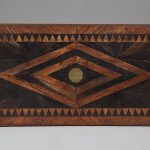
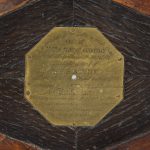
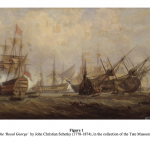

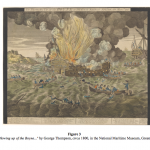

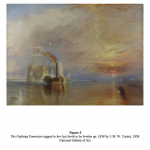
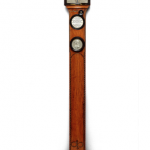
Comments are closed.